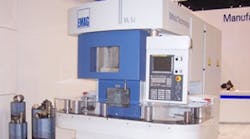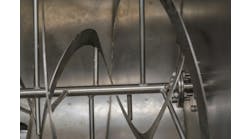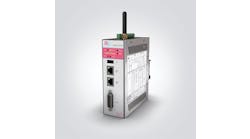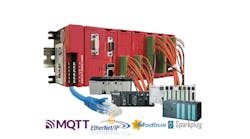Jim Montague is the executive editor for Control, Control Design and Industrial Networking. Email him at [email protected].
Bigger isn't always better, more features aren't always helpful, and many bells and whistles are just noise. All the capabilities a useful machine requires are no more than what each end user needs to produce its products with the greatest speed, accuracy, efficiency, safety and quality. And this directive is even truer for the many small users with shallow pockets who are just beginning to approach using automated machines and production for the first time.
These are the customers that Emag has been reinventing several of its machines to reach. Located in Salish, Germany, and Farmington Hills, Michigan, Emag traditionally builds big, vertical turning, milling and drilling machines with customized control and operations for manufacturing precision metal parts, mainly for the automotive industry. However, to expand into new markets, Emag also began developing smaller, more flexible versions of its larger machines to serve more Tier 1 and 2 parts suppliers and many mom-and-pop machine shops, too.
The VLC 200 H gear-hobbling machine is one of a series of machining centers that Emag has shrunk to one-half to one-third the size of its traditional vertical machines, but which retain the Plus, numerical controls, G-code and capabilities of the company's larger devices.
[PHOTO CREDIT] Jim Montague
"We wanted to get into new market segments with new customers, and so we developed a new modular, standardized concept and introduced it in Europe three years ago and in North America two years ago," says Marius Mazur, Emag's product line manager. "Our traditional machines are two or three times larger than our new modular machines."
How did Emag pack the capabilities of its older, big machines into its new, small ones? Very carefully, especially when integrating its PLC, numerical control (NC), G-code and other essential components into its new half- or one-third-sized footprints. Amazingly, the new, smaller machines still retain the capability of the older and larger cousins, employing Siemens' 840 DSL hybrid PLC and NC controller or Fanuc's 32i and 33i CNC controllers.
"Our new modular machines are the same as our larger ones," says Mazur. "We just put all our knowledge into smaller spaces."
Founded in 1867 in Bautzen, Saxony, as an iron foundry and engineering works, Emag was reestablished in 1952 in Esslingen, Baden-Württemberg, where it manufactured lathes and special-purpose machines. In 1969, it moved to Salish, where it introduced program-controlled, automatic turning machines, which it began distributing worldwide in 1977, including opening its Michigan-based subsidiary in 1980.
One especially important milestone arrived in 1992, when Emag introduced its VSC, which it reports was the world's first vertical turning center with pickup spindle. Over time, the Vices developed into multifunctional, multitasking production centers. For instance, about 10 years ago, Emag also got into machining threaded parts for oil and gas piping applications and developed its VL 3, VL 5 and VL 7 vertical centers. Designed to handle the unique material characteristics and requirements of process industry components, the VL series are typically managed by Fanuc's 32i controller and can be monitored and diagnosed via Emag's Internet protocol (IP)-based, Ethernet network.
Emag's VL 5i vertical machining center is designed to manufacture parts taking into accounts the unique characteristics and requirements of oil and gas piping applications.
[PHOTO CREDIT] Jim Montague
Emag's equipment covers the entire spectrum of machining processes in metalworking. In fact, besides Emag's turning, milling and drilling machines, the larger Emag Group's companies manufacture chucked and shaft-type. Founded, organized or acquired mostly since 2000, these divisions include Kars tens, which makes external, cylindrical grinding equipment; Naxos-Union, which specializes in crankshaft grinding; Emag Automation, which provides automation for all applications; Reinecker, which does internal, precision grinding; Kopp for camshaft grinding; Koepfer for gear hobbing; Emag Laser Tec for assembly and laser welding; and Emag ECM for electrochemical machining.
While its recent modular program started with just one scaled-down machine three years ago, Emag reports its new vertical line includes VL 2, which produces parts up to 100-mm diameter; VL 4, which makes parts up to 200-mm diameter; VL 6, which makes parts up to 600-mm diameter; and VL 8, which makes parts up to 800-mm diameter.
"VL 2 makes small, round gear and chuck parts, while our VT 2 and VT 4 have two spindles, so they're really two machines in one," adds Mazur. "We also typically add our automated part conveyors to the outside of our machines. They're controlled by small Fanuc servo motors and can be on both sides of a machine to move work pieces in and move completed parts out.”
To maintain these controls for its users, Emag operates its Service Plus program, which remotely monitors clients' machines via a password-protected network. "Our users can put their machines on our Emag network, and we can see everything," says Mazur. "Our PLC guys can view the performance of machines on their individual Web pages via our Ethernet-based network."





